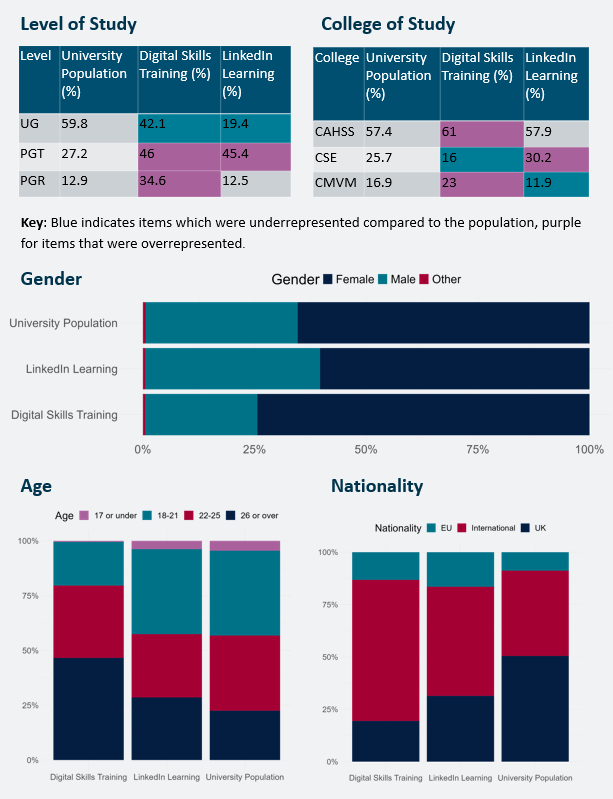Digital skills are vital for career advancement in the 21st century. Previous research has indicated demographic biases in digital skills training offered by the University of Edinburgh, with male undergraduate students studying science and engineering at a risk of being left behind. Training techniques vary significantly depending on training provider or service, and could influence participation across demographic groups. This study investigated the scale and impact of this influence, and provided potential reasoning behind the differences in participation.
The University of Edinburgh offers two opt-in services as a pathway for students to develop digital skills: LinkedIn Learning (LIL), and Digital Skills Training (DST). Both services provide training across a broad spectrum of topics. The courses on LIL are online, asynchronous, self-paced, and do not enable attendees to ask questions or interact with the instructor. In contrast, DST is a training programme set up by the University of Edinburgh, and the courses are provided synchronously and are University instructor-led, with attendees able to ask questions and interact with the instructor and peers.
This study analysed differences in the student ‘type’ that attend each of these training pathways, across various demographics.
Methods
Attendee data from the academic year 2022/23 were gathered from each service provider, with Unique User Identifiers (UUNs) sent to student and staff record holders to match with available demographic data. Anonymised datasets were returned containing 931 attendees of DST and 4840 users of LIL with available demographic information.
The proportions were calculated across:
- Level of study (Undergraduate/UG, Postgraduate Taught/PGT, and Postgraduate Research/PGR)
- College (Arts, Humanities and Social Sciences (CAHSS); Science and Engineering (CSE); Medicine and Veterinary Medicine (CMVM))
- Gender (male; female; other)
- Age (17 or under; 18-21; 22-25; 26 or over)
- Nationality (UK-national; EU; international)
One proportion Z-tests were conducted to identify areas of significant over or underrepresentation when compared with overall University population figures.
Headlines
- Undergraduates and younger students (aged 17-21) were significantly more likely to opt for self-led and asynchronous training, offered by LIL.
- Taught and research postgraduates and older students (aged 22+) were more likely to choose DST, learning in-person from an instructor.
- Male students were more likely to choose LIL, female students DST.
- Students from CSE were more likely to use LIL, whereas students from CAHSS and CMVM were more likely to attend DST.
- International students were equally likely to opt for both forms of training, whereas UK students were significantly more likely to utilise LIL than DST.
- International students were much more likely to take any form of digital skills training than UK students.

Proportions of attendees in each training pathway across demographics explored in the study, including contextual population data.
Discussion
LinkedIn Learning was found to plug the digital skills gaps revealed by previous research, with an increased number of young, male students from CSE learning asynchronously. These were the groups which had historically been underrepresented in Digital Skills Training.
It is now clear that these groups were not necessarily underrepresented across all forms of training, but learning in a different way through other services provided by the University.
However, there was still an overrepresentation of international students across both training pathways, highlighting the potential gap facing UK-national students. A possible explanation may be digital shock and digital border crossing, known phenomena experienced by international students that can result in unfamiliarity with technologies used in UK Universities. As a result, international students may seek out additional training (Chang & Gomes, 2017).
The MHFH (male hubris, female humility) problem may explain gender differences in learning preference. Research indicates that men are less likely to express a lack of knowledge, which may lead to male students preferring asynchronous, independent study compared to instructor-led (Furnham et al., 2001).
Different student demographics clearly find different forms of learning beneficial, demonstrating the importance of understanding who uses these services. This helps identify significant gaps, prevents the exclusion of certain demographics, and provides equal opportunity to digital skills development, improving the long-term diversity of staff in digital research.
Impact
This research was featured in the Digital Research Conference 2025. The Head of Digital Skills Design and Training, Satu Kapiainen, has also written about this work and the impact on the services she leads on – Who attends digital skills training – and why does it matter? – Digital Skills, Design and Training.
References
Chang, S. and Gomes, C. (2017) ‘Digital Journeys: A perspective on understanding the digital experiences of international students’, Journal of International Students, 7(2), pp. 347–466. doi:10.32674/jis.v7i2.385.
Furnham, A., Hosoe, T. and Tang, T.L.-P. (2001) ‘Male hubris and female humility? A crosscultural study of ratings of self, parental, and sibling multiple intelligence in America, Britain, and Japan’, Intelligence, 30(1), pp. 101–115. doi:10.1016/s0160-2896(01)00080-0.


